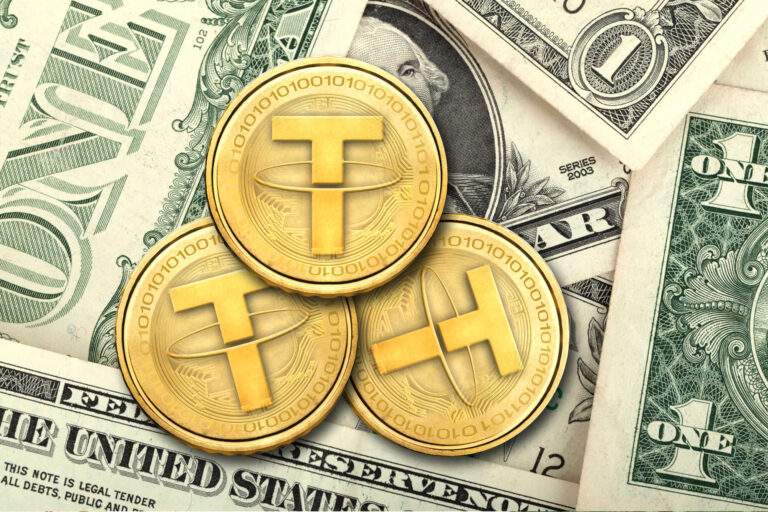Tether Ltd. is one of the oldest and currently largest stablecoin issuers in the space. USDT reached a market capitalisation of $83bn at the peak and still dominates crypto trading pairs across various centralised exchanges. A deep dive into the mechanics and reserves of Tether (USDT).
We take a look at the reserves backing Tether’s USDT stablecoin and compare it to other similar holdings both in DeFi (decentralised finance) and TradFi (traditional finance). The collapse of TerraUSD (UST) has increased skepticism in all stablecoins, algorithmic or not, and raised fresh questions about what reserves, if any, are actually backing these stablecoins. These concerns are being voiced by both investors and users but also politicians and regulatory agencies. Many believe that stablecoins pose risks to both consumers and the broader economy.
Tether's USDT compared to Terra's UST
The value of all UST in circulation before the infamous meltdown was around $18.6bn, of which over $17bn (90%) was deposited into Anchor (a savings dApp on the Terra blockchain). While the value wiped out from the Terra ecosystem was substantial (over $40bn) it was not systemic to the wider crypto space as it only represented less than 2% of the market (1.2T). The case for Tether’s USDT is sizeably different. The circulating supply for USDT currently stands at $74bn, four times more than UST at its peak. Below we show the relative market caps of TerraUSD (UST) and Tether (USDT) over the last 180 days.
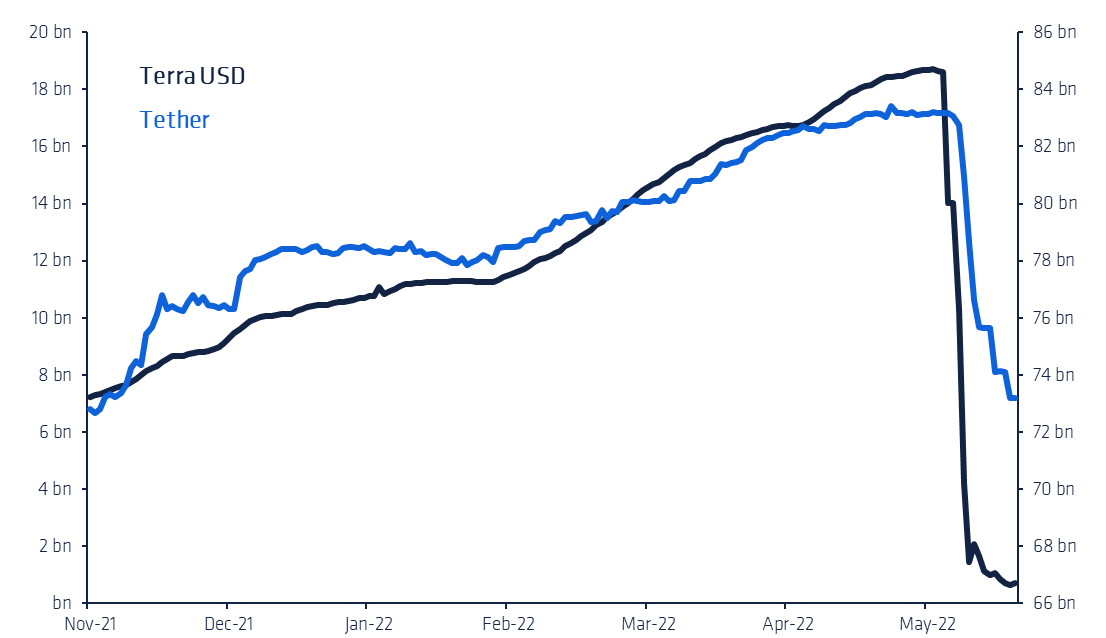
The market cap of UST quickly declined as it lost its peg against the US Dollar (currently at ~$0.06). This event spooked some holders of Tether and led to the redemption of their tokens for US dollars to the tune of $10 billion. For context, Tether redeemed over half of UST’s entire circulating supply in just over a week and didn’t lose its peg (didn’t drop below $0.99). This was by far the largest batch of redemptions ever, yet there weren't any systemic issues.
Tether's backed reserves
Volatility and redemptions aside, what is the Tether stablecoin (USDT) directly backed by, and is it secure? Well, these questions have prompted Tether to release an audited quarterly report on the breakdown of its reserves. These reserves are currently audited by the Cayman-based accountancy firm, MHA Cayman. We highlight the most recent audited breakdown below.
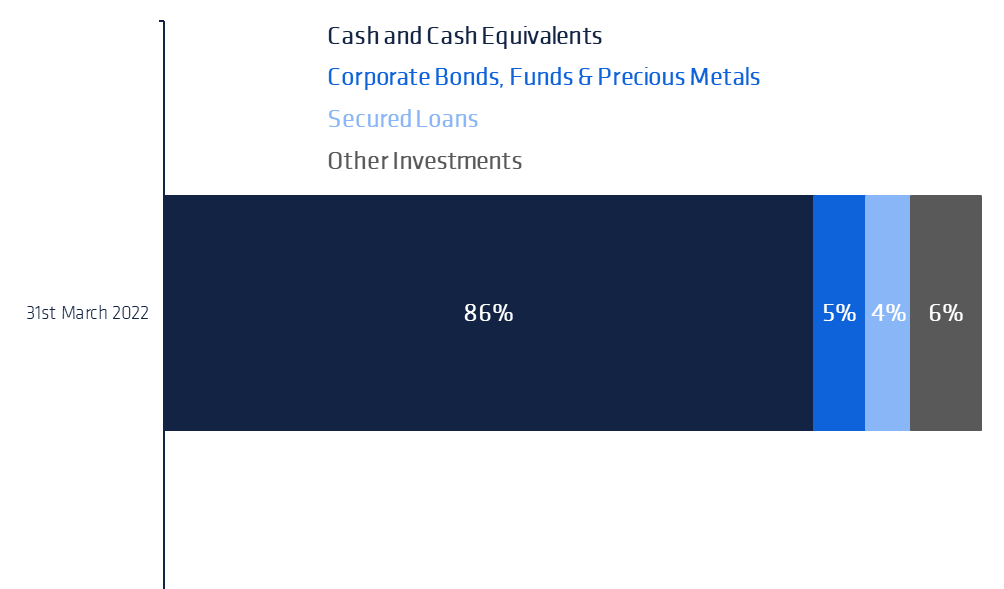
We see that USDT is not financially backed 1:1 by cash (or cash equivalents) but more like 0.85:1. A closer look at cash and cash equivalents shows that just over half is allocated to U.S. Treasury Bills and ~30% is allocated to Commercial Paper (CP) and CDs. The remaining 16% is split between Money Market Funds (~10%), Cash & Bank Deposits (~6%), Non-U.S. Treasury Bills (~0.4%), and Reverse Repos (0.15%).
As for the remaining 14.36%, the audit does not provide much further clarity. The allotment to corporate bonds, funds & precious metals (4.52%) provides no detail on the type of corporate bonds (investment rating, country) nor the type of funds. The type of precious metals is also excluded and the percentage breakdown of these three categories is also opaque. There aren’t any disclosures on the secured loans (3.82%) however it is mentioned that other investments (6.02%) do include digital assets but to what extent is also unknown.
Dominance of U.S Treasury bills
As mentioned above, the breakdowns of the reserve were only provided from June 30th, 2021 (after other stablecoins began to release theirs). For the most part, the allotted weights have remained relatively steady since June 2021 with Cash and Cash Equivalents slightly rising from 85% to 86% while Secured loans remain at 4%. However, other investments (which include digital assets) have doubled from 3% to 6%, increasing the risk level of the reserves. The rise in other investments has come at the expense of Corporate Bonds, Funds & Precious Metals which declined from 8% to 5% over the period. In US dollar terms, for the latest quarter, Cash and Cash Equivalents have increased by 7% while Secured Loans decreased by 24%.
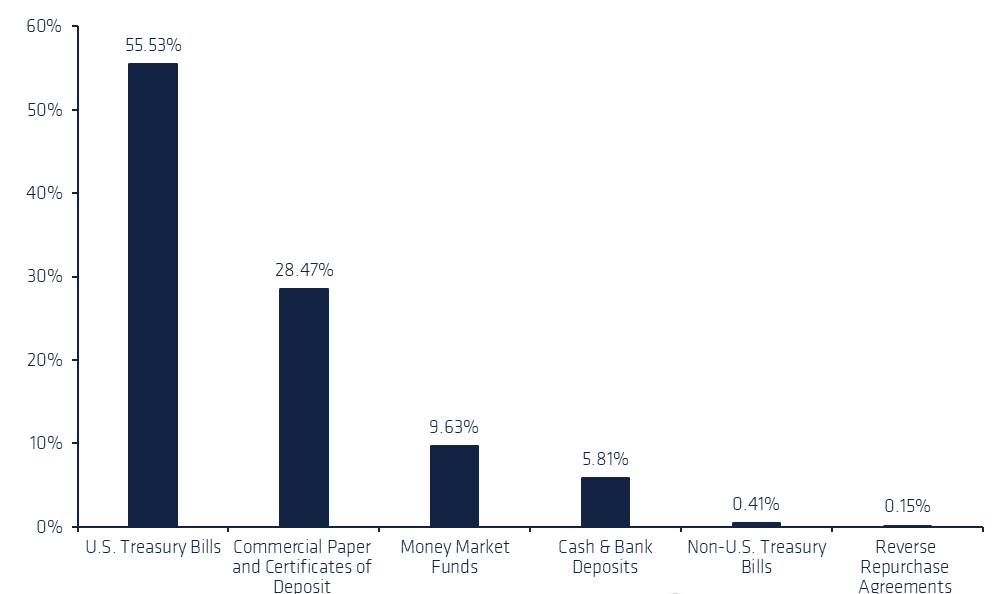
Looking deeper at Cash and Cash Equivalents, we show below that U.S. Treasury Bills have started to become a larger part of the reserves (24% to 48%) thereby replacing the dominance of Commerical Paper and CDs (49% to 24%). This reduction in commercial paper holdings has somewhat eased concerns over the riskiness of these instruments. Cash & Bank Deposits were reduced from 10% to 5% and Reverse Repo Notes decreased from 2% to 0.1%. There has also been an addition of Money Market Funds which now make up 8%, and in the most recent quarter, Non-U.S. Treasury Bills have been added (0.3%). The quality of Tether’s commercial paper continues to be questioned even as its allocation is reduced. Below we show a breakdown of the ratings of Tether’s commercial paper as of March 2022.
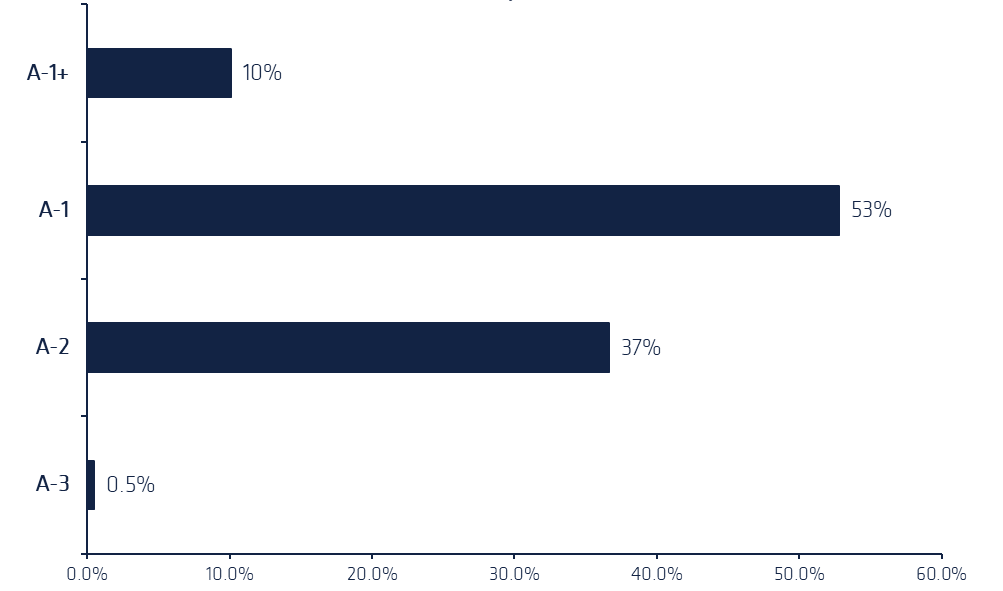
From June 2021, (when Tether started to report its reserve breakdowns) to March 2022, Tether’s reserve has grown 31% from $63bn to $83bn. This growth comprised a 32% increase in cash and cash equivalents, a 25% increase in secured loans, a 23% decrease in corporate bonds et. al, and a 141% increase in other investments (likely due to a rise in digital asset prices).
However, since March 31st 2022, there have been around $10bn in redemptions (~$84bn to ~$74bn) without any detrimental effects. The process for redeeming involves a one-time $150 verification process as well as a fee of 0.1%, while the minimum redemption amount currently stands at $100,000. These constraints can slow down a run on assets if one were to materialise, but as evidenced Tether can already handle a 10-figure redemption in just over a week.
Comparisons with other MMFs
So how do Tether’s reserves compare against leading money market funds (MMFs)? As outlined in the audit report, 8% of Tether’s reserves comprise money market funds although the details of these funds are not disclosed. We examine the portfolio breakdown of a few top money market funds by assets under management (AUM) and compare the holdings as of the last quarter. We see below that mutual funds can vary widely in terms of fixed income holdings although commercial paper repurchase agreements and certificates of deposit appear to be popular choices.
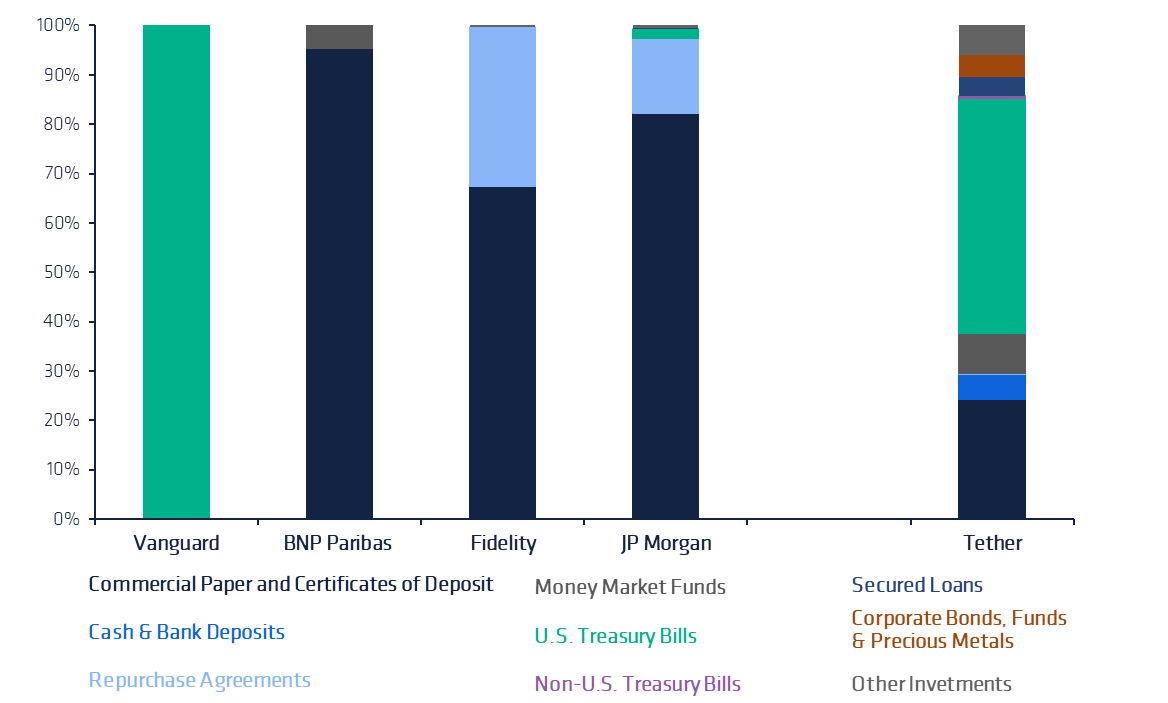
While it’s useful to contrast the differences between money market funds and a stablecoin reserve it’s not exactly an apples-to-apples comparison. Tether was the first major stablecoin and had market dominance for a few years. However, in recent times, Circle’s USDC and Binance’s BUSD have gained significant market share among the leading stablecoins (~37% and ~13% respectively). Furthermore, Tether commands a ~33% market share of all stablecoin/BTC trading volumes on trusted exchanges though this too is also waning. The relative importance of USDT is evidently in decline.
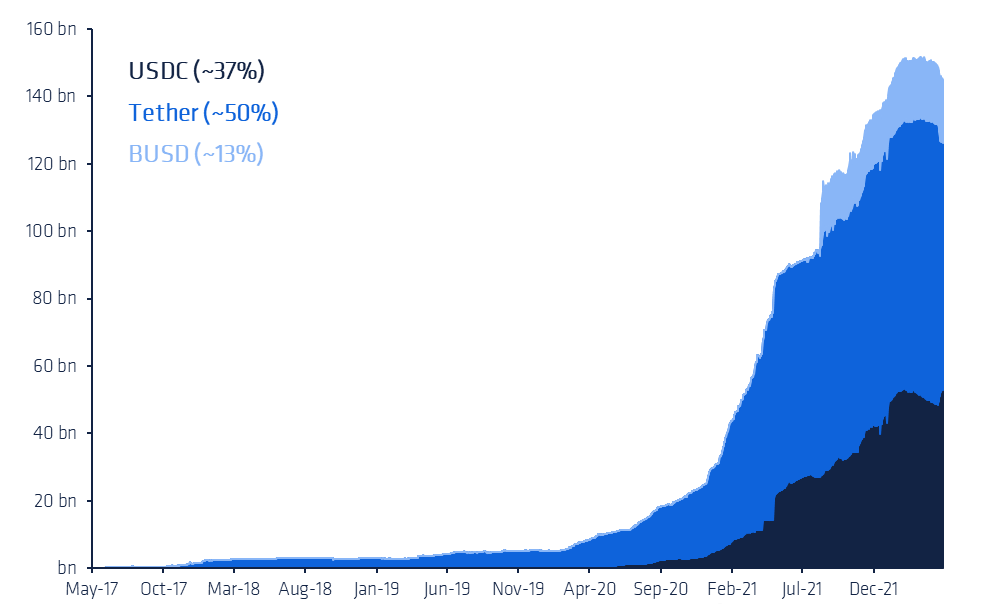
All three coins are pegged to the US dollar at a 1:1 ratio and both Circle and Binance/Paxos undergo and publish monthly audits as opposed to Tether’s quarterly reports. While USDT always shows its reserves, it doesn’t provide public information on auditing which may be a concern for investors. Despite the differences in transparency reporting, there is some variation in the reserves among these stablecoins.
Outlook for the future
The world’s most popular stablecoin, Tether, has been around since early 2015 and has withstood many tests and a few black swan events. The first mover’s advantage plus the real-world tests have increased confidence in USDT as evidenced by the growth in circulating supply.
However, the real test may be yet to come and renewed concerns over stablecoin reserves have caused a 12% reduction in USDT circulation through recent redemptions. Furthermore, competitors such as Circle have more transparent reporting in a more trustworthy regulatory environment. This perceived safety of USDC (and others) continues to lead to a decline in Tether’s market share. As seen before, this trend may result in Tether adopting more sturdy reserves, greater transparency, and more diligent auditing practices. The alternative seems to be a reduction in trust, market share, and outstanding coins which will result in a materially less important market player. A path toward the former reduces the risk for all while a path toward the latter makes the question “Is Tether a systemic risk to the crypto market?” a less relevant question.

